Pubic flowers
| Pubic flowers | ||||||||||||
|---|---|---|---|---|---|---|---|---|---|---|---|---|

|
||||||||||||
| Systematics | ||||||||||||
|
||||||||||||
| Scientific name | ||||||||||||
| Aeschynanthus | ||||||||||||
| Jack |
The shame flowers ( Aeschynanthus ) are a genus within the family of Gesneriad (Gesneriaceae). The approximately 140 to 185 species are distributed in the Paleotropic to southern and southeastern Asia and Oceania . Some types of shame flowers such as Aeschynanthus radicans or Aeschynanthus × splendidus are used as flowering ornamental plants , especially as house plants .
description



Within the 140 to 185 species of the genus Aeschynanthus there are relatively large differences in all morphological characteristics such as general growth habit, leaf and flower shape and flower color.
Vegetative characteristics
Aeschynanthus species are perennial herbaceous plants to subshrubs that are usually evergreen . With Aeschynanthus fulgens and Aeschynanthus micranthus there are even succulent species. The mostly hanging, rarely independently upright or rarely climbing, branched or unbranched shoot axes can be up to 60 centimeters long.
The mostly many, often opposite, sometimes whorled on the stem axis arranged leaves are divided into petiole and leaf blade. The opposite pairs of leaves can be the same or different. The simple, entire, leaf blades are shaped very differently. The shape of the leaf blade is narrow, linear, oval-ovate to rounded. The base of the blade is wedge-shaped to rounded or narrows towards the petiole. The leaf blades can be either soft-leaved and rarely hairy or mostly bald and covered with a thick layer of cuticle . Only in Aeschynanthus longicaulis are green and white marbled leaves.
Generative characteristics
The flowers are solitary or up to ten loosely or rarely close together in lateral or pseudo-terminal, umbel-like, zymous inflorescences . There are two opposite bracts .
The hermaphrodite flowers are zygomorphic and five-fold with a double flower envelope . Depending on the species, the five sepals are only at their base (for example Aeschynanthus longicaulis ) or almost completely (for example Aeschynanthus pulcher ) fused to form a tube. The five calyx lobes are the same or rarely different. The corolla is red to orange, rarely green, yellow or white. The corolla is sparsely downy or hairy on the inside or there is only a ring with trichomes or it is bare. The five petals are fused to form a narrow to funnel-shaped corolla tube, which is often curved. The corolla tube has a diameter of 4 to 15 millimeters and is much longer than the free part of the crown. The free part of the crown is indistinct to very clearly two-lipped. The bilobed upper lip is usually the same length or rarely up to half as long as the lower lip. The three corolla lobes of the lower lip are ± the same length and are rounded to pointed at the upper end. Of the four fertile stamens that have grown together with the corolla tube, two hang together at the upper ends and protrude above the corolla tube. There may be a staminodium that is fused with the corolla tube. The counters, which open in the longitudinal direction, are parallel to each other. The discus is ring-like. The linear, unicameral ovary contains two parietal placentas. The individual stylus ends in an undivided and heady to flattened spherical scar.
The capsule fruit is straight in relation to the stalk. The linear capsule fruits are many longer than the calyx, can be up to 50 centimeters long in some species, open with two or four straight fruit valves without twisting towards their base and they contain one or two to many (up to 50) seeds. On the seed there are usually some at one end and a hair-like appendage at the other, rarely only one elongated appendage is present at both ends.
ecology
Aeschynanthus species grow mainly epiphytically or lithophytically . Only a few species grow terrestrially.
In Aeschynanthus TYPES strict is protandry ago. During anthesis the length of the changes stamens and the stylus clearly. The pollination is usually by birds ( ornithophily ).
Systematics and distribution
The name composition of the generic name Aeschynanthus cannot be clearly clarified. One possible derivation is from the Greek word for shame aischyne ( αἰσχύνη ) and anthos ( ἄνθος ) for flower. The association with shame could come from the red color of the flowers. Another, less likely, word stem would be the Greek verb aischýnein ( αἰσχύνειν ), "to deface ". Here the shape of the strongly fused petals would be a possible reason for the naming.
The genus Aeschynanthus was set up in 1823 by the American botanist William Jack in Transactions of the Linnean Society of London , 14, p. 42, he was a member of the Democratic Party of the House of Representatives of the United States . Type species is Aeschynanthus volubilis Jack . Synonyms for Aeschynanthus Jack nom. cons. are: Euthamnus Schltr. , Oxychlamys Schltr. , Rheitrophyllum Hassk. , Trichosporum D.Don .
The genus Aeschynanthus occurs in Asia and Oceania . The individual species are widespread there. 34 species are found in China alone , further distribution areas are India and, in the oceanic region, the Philippines , Java , Malaysia , New Guinea and the Solomon Islands .
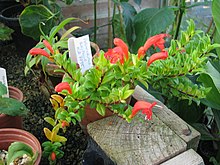
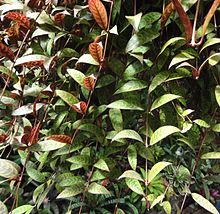
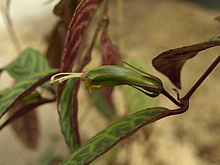


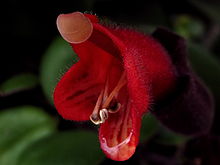
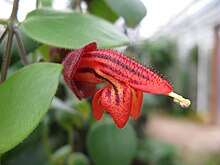

There are 140 to 185 Aeschynanthus species:
- Aeschynanthus acuminatissimus W.T.Wang : This endemic thrives on trees in densely forested valleys at altitudes of 1200 to 1500 meters only in Xichou in southeastern Yunnan .
- Aeschynanthus acuminatus Wall. ex A.DC. (Syn .: Aeschynanthus acuminatus var. Chinensis (Gardner & Champion) CBClarke , Aeschynanthus acuminatus Wall. Nom. Nud., Aeschynanthus bracteatus sensu Benth. Non Wallich ex DC. , Aeschynanthus chinensis Gardner & Champion ): It is in northern India , in Bhutan , Nepal , Myanmar , Laos , Thailand , northern Vietnam , Malaysia , Japan , Taiwan , southeast Tibet and the Chinese provinces of Guangdong , Guangxi , Sichuan, and southern to southeastern Yunnan.
- Aeschynanthus albidus (flower) Steud. (Syn .: Aeschynanthus atropurpureus Van Houtte , Aeschynanthus discolor T.Moore , Aeschynanthus fraserianus Kränzl. , Aeschynanthus motleyi C.B.Clarke , Aeschynanthus motleyi var. Ceramensis C.B.Clarke , Aeschynanthus motleyi var. Sumatrensis C.B.Clarke , Aeschynanthus purpurascens Hasskarl )
- Aeschynanthus amboinensis (Merr.) Mendum
- Aeschynanthus amoenus C.B. Clarke
- Aeschynanthus andersonii C.B. Clarke (Syn .: Aeschynanthus hildebrandii Hemsl. Ex Hook. F. ): It occurs only in southwest to southern Yunnan and in northeastern Myanmar.
- Aeschynanthus angustifolius (flower) Steud. (Syn .: Aeschynanthus stenophyllus Ridley , Aeschynanthus tetraquetrus C.B.Clarke )
- Aeschynanthus angustioblongus W.T.Wang : This endemic thrives on trees in wooded valleys at altitudes of around 1500 meters only in Gongshan in northwestern Yunnan.
- Aeschynanthus angustissimus (WTWang) WTWang : This endemic thrives on trees and rocks in laurel forests at altitudes of around 2300 meters only in Mêdog in southeastern Tibet.
- Aeschynanthus apicidens Hance
- Aeschynanthus arctocalyx Mendum & Madulid
- Aeschynanthus arfakensis C.B. Clarke
- Aeschynanthus argentii Mendum
- Aeschynanthus asclepioides (Elmer) BLBurtt & P.Woods (Syn .: Aeschynanthus stenocalyx Kraenzl. )
- Aeschynanthus atrorubens Schltr.
- Aeschynanthus atrosanguineus Van Houtte ex CBClarke
-
Aeschynanthus austroyunnanensis W.T.Wang : There have been two varieties since 1990:
- Aeschynanthus austroyunnanensis W.T.Wang var. Austroyunnanensis : It thrives on rocks by flowing waters at altitudes of 50 to 1500 meters only in southern to southeastern Yunnan.
- Aeschynanthus austroyunnanensis var. Guangxiensis (WYChun ex WTWang & KYPan) WTWang (Syn .: aeschynanthus guangxiensis W.Y.Chun ex WTWang & KYPan ): It grows on limestone at altitudes of 400 to 1000 meters only in the western Guangxi and in Zhenfeng in the southwestern Guizhou.
- Aeschynanthus batakiorum Mendum & Madulid
- Aeschynanthus batesii Mendum
- Aeschynanthus brachyphyllus S.Moore
- Aeschynanthus bracteatus Wall. ex A.DC. (Syn .: Aeschynanthus bracteatus var. Orientalis W.T.Wang , Aeschynanthus bracteatus Wall. Nom. Nud., Aeschynanthus paxtonii Lindl. , Aeschynanthus peelii Hook. F. & Thoms. ): It occurs in northeastern India, in Bhutan, Myanmar, in the southeast Tibet and the Chinese provinces of northwestern Guangxi and Yunnan.
- Aeschynanthus brevicalyx Miq.
- Aeschynanthus breviflorus (S.Moore) K.Schum.
- Aeschynanthus burttii Mendum
- Aeschynanthus buxifolius Hemsl. : It occurs in Vietnam and in the Chinese provinces of Guangxi , southwestern Guizhou and Yunnan.
- Aeschynanthus calanthus Schltr.
- Aeschynanthus cambodiensis D.J. Middleton
- Aeschynanthus candidus Hend. ex CBClarke
- Aeschynanthus cardinalis (Copel. Ex Merr.) Schltr.
- Aeschynanthus caudatus C.B. Clarke
- Aeschynanthus celebicus coord.
- Aeschynanthus ceylanicus Gardner
- Aeschynanthus chiritoides C.B.Clarke (Syn .: aeschynanthus denticuliger W.T.Wang , aeschynanthus pusillus Prain )
- Aeschynanthus chorisepalus Orr
- Aeschynanthus chrysanthus P. Woods
- Aeschynanthus citrinus Mendum & SMScott
- Aeschynanthus copelandii (Merr.) Schltr. (Syn .: Aeschynanthus camiguinensis Kraenzl. , Aeschynanthus serpens Kraenzl. )
- Aeschynanthus cordifolius Hook.
- Aeschynanthus crassifolius (Elmer) Schltr. (Syn .: Aeschynanthus foxworthyi Kraenzl. , Aeschynanthus glomeriflorus Kraenzl. , Aeschynanthus polillensis Kraenzl. )
- Aeschynanthus cryptanthus C.B. Clarke
- Aeschynanthus cuernosensis (Elmer) Schltr.
- Aeschynanthus curtisii C.B. Clarke
- Aeschynanthus curvicalyx Mendum
- Aeschynanthus dasycalyx Hallier f.
- Aeschynanthus dempoensis S. Moore
- Aeschynanthus denticuliger W.T.Wang : It occurs in Laos, northern Vietnam and southeastern Yunnan.
- Aeschynanthus dischidioides (Ridl.) DJMiddleton (Syn .: Aeschynanthus myrmecophilus P. Woods )
- Aeschynanthus dischorensis Schltr.
- Aeschynanthus dolichanthus W.T.Wang : This endemic thrives on rocks in river valleys at altitudes of around 900 meters only in Mêdog in southeastern Tibet.
- Aeschynanthus dunnii H.Lév.
- Aeschynanthus ellipticus K.Schum. & Lauterb.
- Aeschynanthus elmeri Mendum
- Aeschynanthus elongatus C.B. Clarke
- Aeschynanthus everettianus Kraenzl.
- Aeschynanthus fecundus P. Woods
- Aeschynanthus firmus Kraenzl.
- Aeschynanthus flammeus Schltr.
- Aeschynanthus flavidus Mendum & P. Woods
- Aeschynanthus flippancei Ridl.
- Aeschynanthus forbesii K.Schum.
- Aeschynanthus fruticosus Ridl.
- Aeschynanthus fulgens Wall. ex R.Br. (Syn .: Aeschynanthus evrardii Pellegr. , Aeschynanthus fulgens Wall. Nom. Nud., Aeschynanthus stenosiphonius W.T.Wang )
- Aeschynanthus garrettii Craib
- Aeschynanthus geminatus inch. & Moritzi
- Aeschynanthus gesneriflorus S.Moore
- Aeschynanthus gjellerupii Schltr.
- Aeschynanthus gracilis Parish ex CBClarke (Syn .: Aeschynanthus novogracilis W.T.Wang nom. Superfl., Aeschynanthus setosus Kraenzl. ): It occurs in Bhutan, Sikkim , in northern Myanmar, in Thailand, in northern Vietnam and in southern Yunnan.
- Aeschynanthus guttatus P. Woods
- Aeschynanthus hartleyi P. Woods
- Aeschynanthus hians C.B. Clarke
- Aeschynanthus hildebrandii Hemsl. : It occurs in Thailand and Myanmar.
- Aeschynanthus hispidus Schltr.
- Aeschynanthus hookeri C.B.Clarke : It occurs in Bhutan, in northern India, in northern Myanmar and in northwestern and southern Yunnan.
- Aeschynanthus horsfieldii R.Br. (Syn .: Aeschynanthus rubiginosus Teijs. & Binn. )
- Aeschynanthus hoseanus Kraenzl.
- Aeschynanthus hosseusii Pellegr.
- Aeschynanthus humilis Hemsl. : This endemic thrives on trees in wooded valleys at altitudes of 1300 to 2100 meters only in Jingdong , Pingbian and Simao in Yunnan.
- Aeschynanthus impar Schltr.
- Aeschynanthus intraflavus Mendum
- Aeschynanthus irigaensis (Merr.) BLBurtt & P.Woods
- Aeschynanthus janowskyi Schltr.
- Aeschynanthus jouyi D.J. Middleton
- Aeschynanthus kermesinus Schltr.
- Aeschynanthus kingii C.B. Clarke
- Aeschynanthus lancilimbus W.T.Wang : This endemic thrives in densely forested valleys at altitudes of around 1200 meters only in Yanshan in Yunnan.
- Aeschynanthus lasianthus W.T.Wang : This endemic thrives on trees at the edges of forests and on rock walls by flowing waters at altitudes of 1700 to 2600 meters only in Gongshan in northwestern Yunnan.
- Aeschynanthus lasiocalyx W.T.Wang : This endemic thrives in forests on rocks in river valleys at altitudes of around 800 meters only in Mêdog in southeastern Tibet.
- Aeschynanthus lepidospermus C.B.Clarke
- Aeschynanthus leptocladus C.B. Clarke : It occurs in Papua New Guinea.
- Aeschynanthus leucothamnos Kraenzl.
- Aeschynanthus levipes C.B. Clarke
- Aeschynanthus ligustrinus Schltr.
- Aeschynanthus linearifolius C.EC fish. (Syn .: Aeschynanthus linearifolius . Var oblanceolatus (Anthony) WTWang , Aeschynanthus oblanceolatus (Anthony) CECFischer , Aeschynanthus peelii var. Oblanceolatus Anthony ): It comes in northeastern India, northern Myanmar, southeastern Tibet and Yunnan ago.
- Aeschynanthus lineatus Craib (Syn .: Aeschynanthus chorisepalus Orr. ): It occurs in northern Thailand and in southern and western Yunnan.
- Aeschynanthus littoralis (Merr.) Schltr.
- Aeschynanthus lobaticalyx Mendum
- Aeschynanthus loheri Kraenzl.
- Aeschynanthus longicaulis Wall. ex R.Br. (Syn .: Aeschynanthus griffithii R.Br. , Aeschynanthus longicaulis Wall. Nom. Nud., Aeschynanthus marmoratus T.Moore , Aeschynanthus zebrinus Van Houtte ): It occurs in southern Yunnan, Myanmar, Thailand, Vietnam and Malaysia.
- Aeschynanthus longiflorus (flower) A.DC. (Syn .: Aeschynanthus perakensis Ridl. ): It occurs in Indonesia.
- Aeschynanthus macranthus (Merrill) Pellegr. : It occurs in southeastern Yunnan, northern Vietnam, in Laos and Thailand.
- Aeschynanthus macrocalyx C.B. Clarke
- Aeschynanthus maculatus Lindl. : It occurs in southern Tibet, Bhutan and Nepal.
- Aeschynanthus madulidii Mendum
- Aeschynanthus magnificus Stapf
- Aeschynanthus mannii Kurz ex CBClarke
- Aeschynanthus marginatus Ridl.
- Aeschynanthus masoniae Short ex CBClarke
- Aeschynanthus medogensis W.T.Wang : This endemic thrives on trees in forests at altitudes of around 1900 meters only in Mêdog in southeastern Tibet.
- Aeschynanthus membranifolius (Costantin) DJMiddleton
- Aeschynanthus mendumiae D.J.Middleton
- Aeschynanthus mengxingensis W.T.Wang : This endemic thrives on the edges of forests in valleys and on tree trunks in forests on limestone hills at altitudes of 700 to 800 meters only in Cangyuan in southern Yunnan.
- Aeschynanthus meo K. Schum.
- Aeschynanthus microcardius B.L.Burtt & RADavidson
- Aeschynanthus microphyllus C.B. Clarke
- Aeschynanthus microtrichus C.B. Clarke
- Aeschynanthus mimetes B.L.Burtt : It occurs in northeast India, southeast Tibet and southern and western Yunnan.
- Aeschynanthus miniaceus B.L.Burtt & P.Woods
- Aeschynanthus miniatus Lindl.
- Aeschynanthus minutifolius D.J. Middleton
- Aeschynanthus mollis Schltr.
- Aeschynanthus monetarius Dunn
- Aeschynanthus moningerae (Merr.) Chun : It thrives on trees in forests and on rocks in river valleys at altitudes of 300 to 1200 meters in the Chinese provinces of Guangdong and Hainan .
- Aeschynanthus montisucris P.Royen
- Aeschynanthus musaensis P. Woods
- Aeschynanthus myrtifolius Schltr.
- Aeschynanthus nabirensis Kaneh. & Hatus.
- Aeschynanthus nervosus (Elmer) Schltr.
- Aeschynanthus nummularius (Burkill & S.Moore) K.Schum.
- Aeschynanthus obconicus C.B.Clarke
- Aeschynanthus obovatus C.B. Clarke
- Aeschynanthus ovatus (Merr.) Schltr.
- Aeschynanthus oxychlamys Mendum
- Aeschynanthus pachyanthus Schltr.
- Aeschynanthus pachytrichus W.T.Wang : This endemic thrives on trees in mountain forests at altitudes of around 1000 meters only in Yingjiang in western Yunnan.
- Aeschynanthus papuanus (Schltr.) BLBurtt
- Aeschynanthus parasiticus (Roxb.) Wall. (Syn .: Aeschynanthus andamanensis Goel, Vasudeva Rao & Mehrotra , Aeschynanthus deleiensis C.ECFischer , Aeschynanthus GRANDIFLORUS (D.Don) Spreng. , Aeschynanthus GRANDIFLORUS var. Parasiticus (Roxb.) CBClarke , Aeschynanthus parasiticus (Roxb.) DBDeb comb. Superfl ., Aeschynanthus roxburghii Paxt. Ex CB Clarke ): It occurs in northeastern India, in Bhutan, Nepal and Myanmar.
- Aeschynanthus parviflorus (D.Don) Spreng. (Syn .: Aeschynanthus consobrinus Kränzl. , Aeschynanthus maculatus var. Sikkimensis C.B.Clarke , Aeschynanthus maculatus var. Stenophyllus C.B.Clarke , Aeschynanthus ramosissimus Wall. Nom. Superfl., Aeschynanthus ramosissimus Wall. . Nud nom., Aeschynanthus sikkimensis (CBClarke) Stapf ) : It occurs in India, Bhutan and Nepal.
- Aeschynanthus parvifolius R. Br . : It occurs in Malaysia and Indonesia.
- Aeschynanthus pedunculatus D.J. Middleton
- Aeschynanthus pergracilis Kraenzl.
- Aeschynanthus perrottetii A.DC. (Syn .: Aeschynanthus ceylanicus Wight non Gardner , Aeschynanthus GRANDIFLORUS J.Graham non (D.Don) Spreng. , Aeschynanthus perrottetii var. Planiculmis C.B.Clarke , Aeschynanthus perrottetii var. Platyculmis C.B.Clarke , Aeschynanthus planiculmis (CBClarke) Gamble )
- Aeschynanthus persimilis Craib (Syn .: Aeschynanthus hosseusianus Kraenzl. ): It is native to Thailand.
- Aeschynanthus phaeotrichus Schltr.
- Aeschynanthus philippinensis C.B. Clarke
- Aeschynanthus planipetiolatus H.W.Li : This endemic thrives on trees on slopes along roads at altitudes of around 1600 meters only in Menghai in southern Yunnan.
- Aeschynanthus podocarpus C.B. Clarke
- Aeschynanthus poilanei Pellegr. : It occurs in Vietnam and in southeastern Yunnan.
- Aeschynanthus praelongus Kraenzl.
- Aeschynanthus pseudohybridus Mendum
- Aeschynanthus pulcher (flower) G.Don (Syn .: aeschynanthus beccarii C.B.Clarke , aeschynanthus blumei Moritz ex CB Clarke , aeschynanthus boschianus De Briese in Morren , aeschynanthus intermedius Teijsm. & Binn. , Aeschynanthus javanicus Rollinson ex Hook. , Aeschynanthus lamponga Miq. , Aeschynanthus lamponga var. obtusus C.B.Clarke , Aeschynanthus lampongus var. parvifolius Ridl. , Aeschynanthus lanceolatus Ridl. , Aeschynanthus lobbianus Hook. , Aeschynanthus neesii inches. & Moritzi nom. nud., Aeschynanthus parvifolius R.Br. , Aeschynanthus pulcher var. breviflorus Teijsm. & Binn. Nom. Nud., Aeschynanthus szcokhoffii Hort. Berol. Ex CBClarke nom. Nud. Pro syn., Aeschynanthus volubilis Miq. , Aeschynanthus Zollingeri C.B.Clarke ): It occurs on Java.
- Aeschynanthus pullei Schltr.
- Aeschynanthus radicans Jack : It occurs in Malaysia, Singapore and Java.
- Aeschynanthus rarus Schltr.
- Aeschynanthus rhododendron Ridl. (Syn .: Aeschynanthus longicalyx var. Superbus Ridl. , Aeschynanthus longicalyx Ridl. )
- Aeschynanthus rhodophyllus Kraenzl.
- Aeschynanthus roseoflorus Mendum
- Aeschynanthus roseus Schltr.
- Aeschynanthus sanguineus Schltr.
- Aeschynanthus sinolongicalyx W.T.Wang (Syn .: Aeschynanthus longicalyx H.W.Li non Ridl. ): This endemic thrives as a shrub in forests and in bamboo thickets in mountain regions at altitudes of around 800 meters in Pingbian in southeastern Yunnan.
- Aeschynanthus siphonanthus C.B. Clarke (Syn .: Aeschynanthus gibbsiae S.Moore ex Gibbs )
- Aeschynanthus sojolianus Mendum & LERGalloway
- Aeschynanthus solomonensis P. Woods
- Aeschynanthus speciosus Hook. (Syn .: Aeschynanthus aucklandiae Low , Aeschynanthus aucklandii hort.): It occurs in Malaysia, Java and Kalimantan.
- Aeschynanthus × splendidus T. Moore
- Aeschynanthus stenosepalus J.Anthony (Syn .: Aeschynanthus tenuis Hand.-Mazz. ): It occurs in northern Myanmar, in Mêdog in southeastern Tibet and in northwestern Yunnan.
- Aeschynanthus stenosiphon Schltr.
- Aeschynanthus suborbiculatus S. Moore
- Aeschynanthus superbus C.B.Clarke : It occurs in northeastern India, Bhutan, northern Myanmar, in Mêdog in southeastern Tibet and in southeastern and western Yunnan.
- Aeschynanthus tenericaulis Diels
- Aeschynanthus tengchungensis W.T.Wang : This endemic thrives on trees in laurel forests at altitudes of 1700 to 2300 meters only in Gongshan and Tengchong in Yunnan.
- Aeschynanthus teysmannianus Miq.
- Aeschynanthus tirapensis Bhattacharyya
- Aeschynanthus torricellensis Schltr.
- Aeschynanthus trichocalyx Kraenzl.
- Aeschynanthus tricolor Hook. : It occurs in Malaysia and Indonesia.
- Aeschynanthus truncatus (Elmer) Schltr.
- Aeschynanthus tubiflorus C.B. Clarke
- Aeschynanthus tubulosus J.Anthony : The approximately two varieties occur in northern Myanmar and in southwest to western Yunnan.
- Aeschynanthus verticillatus C.B. Clarke
- Aeschynanthus vinaceus P. Woods
- Aeschynanthus viridiflorus Teijsm. & Binn.
- Aeschynanthus volubilis Jack
- Aeschynanthus wallichii Benn.
- Aeschynanthus wardii Merr. : It occurs in northern Myanmar and northwest to western Yunnan.
- Aeschynanthus warianus Schltr.
- Aeschynanthus zamboangensis Kraenzl.
swell
- Anton Weber, Laurence E. Skog: The Genera of Gesneriaceae from the Faculty of Botany at the University of Vienna & Department of Systematic Biology, Botany Smithsonian Institution, 2007: Aeschynanthus .
- The Gesneriad Reference Web - entry Aeschynanthus .
- Select Aeschynanthus at Gesneriaceae Research - World Checklist of Gesneriaceae . (Section systematics)
- Wencai Wang, Kai-yu Pan, Zhen-yu Li, Anna L. Weitzman, Laurence E. Skog: Gesneriaceae. Aeschynanthus , p. 375 - online with the same text as the printed work , In: Wu Zheng-yi, Peter H. Raven (ed.): Flora of China , Volume 18 - Scrophulariaceae through Gesneriaceae , Science Press and Missouri Botanical Garden Press, Beijing and St Louis, 1998, ISBN 0-915279-55-X . (Sections Description and Distribution)
further reading
- David John Middleton: A revision of Aeschynanthus (Gesneriaceae) in Thailand. In: Edinburgh Journal of Botany , Volume 64, 2007, pp. 363-429.
- David John Middleton: A revision of Aeschynanthus (Gesneriaceae) in Cambodia, Laos and Vietnam. In: Edinburgh Journal of Botany , Volume 66, Issue 03, November 2009, pp. 391-446. doi : 10.1017 / S0960428609990047
Individual evidence
- ^ Fritz Encke : cold and warm house plants. 2nd edition, Ulmer, Stuttgart 1987, ISBN 3-8001-6191-5 .
- ^ Alfred Byrd Graf : Tropica , Color Cyclopedia of Exotic Plants and Trees for Warm-Region Horticulture - in Cool Climate the Summer Garden or Sheltered Indoors. 2nd revised and expanded edition, Roehrs, East Rutherford, NJ 1981, ISBN 978-0911266269 .
- ↑ a b c d e f g h i j k l m n o p q r s t u v w x y z aa ab ac ad ae af ag ah ai aj ak al am an ao ap aq ar as at au av aw ax ay az ba Wencai Wang, Kai-yu Pan, Zhen-yu Li, Anna L. Weitzman, Laurence E. Skog: Gesneriaceae. Aeschynanthus , p. 375 - online with the same text as the printed work , In: Wu Zheng-yi, Peter H. Raven (ed.): Flora of China , Volume 18 - Scrophulariaceae through Gesneriaceae , Science Press and Missouri Botanical Garden Press, Beijing and St Louis, 1998, ISBN 0-915279-55-X .
- ↑ Hans Jessen, Helmut Schulze: Botanical dictionary for gardeners and florists : With over 2000 names. 24th, unchanged. Edition, Schaper, Hannover 2008. ISBN 978-3-7944-0220-5 .
- ↑ Aeschynanthus at Tropicos.org. Missouri Botanical Garden, St. Louis, accessed December 3, 2018.
- ↑ a b c d e f g h i j k Gesneriaceae in the Germplasm Resources Information Network (GRIN), USDA , ARS , National Genetic Resources Program. National Germplasm Resources Laboratory, Beltsville, Maryland. Accessed December 1, 2018.
- ↑ Select Aeschynanthus from Gesneriaceae Research - World Checklist of Gesneriaceae .
- ↑ a b c d e f g h i j k l m n o p q r s Jingyun Fang, Zhiheng Wang, Zhiyao Tang (eds.): Atlas of Woody Plants in China: Distribution and Climate , Volume 1, Springer Science & Business Media, 2011, ISBN 978-3-6421-5017-3 . Aeschynanthus pp. 1607-1613.
Web links
- Aeschynanthus at Tropicos.org. In: IPCN Chromosome Reports . Missouri Botanical Garden, St. Louis